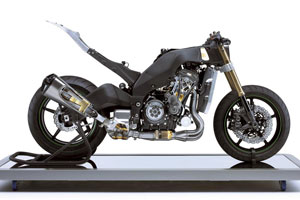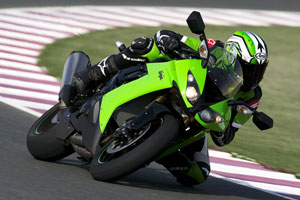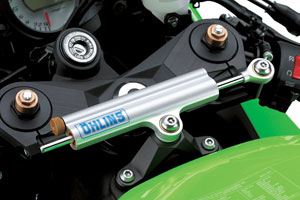Kawasaki’s powerhouse ZX-10R gets a rider-friendly makeover for 2008. Did it translate from beast to best?

ANTI SPIN
The new ZX-10R was hyped up to the max when rumours started spreading that it had traction control. The Kawasaki Ignition Management System (KIMS) is an aid to give extra traction, but it’s not quite proper traction control. Kawasaki refers to it as anti spin.
KIMS has sensors throughout the bike monitoring engine speed, throttle position, vehicle speed, gear position, feedback from the intake air temperature, intake air pressure, engine temperature and oxygen, and it also monitors any changes in RPM.
Run through the ECU, the complex program was developed through extensive rider testing and should a significant change in engine speed be detected, the sensors noted above are taken into account and when necessary, ignition timing is slowed, curtailing sudden spikes in engine speed and controlling the rear-wheel spin to a point.
This system is almost identical to the ones being used in the ASC, where teams are adopting aftermarket ECUs with an option for their own anti-spin. Cool, eh?
SPECIFICATIONS
ENGINE
Engine type: Liquid-cooled, 4-stroke In-Line Four
Bore x stroke: 76.0 x 55.0 mm
Displacement: 998cc
Compression ratio: 12.9:1
Transmission: Six speed
Power (claimed): 185hp (197hp with ram air)
Torque (claimed): 83ft-lbs
CHASSIS
Frame type: Backbone/Twin-tube, aluminium (Pressed/die-cast composite structure)
Front suspension: 43 mm inverted fork with DLC coating,
rebound and compression damping, spring preload
adjustability and top-out springs
Rear suspension: Bottom-Link Uni-Trak with gas-charged shock and top-out spring
Wheelbase: 1415 mm
Wheels (front/rear):
Tyres (front/rear): 120/70ZR17M/C (58W) / 190/55ZR17M/C (75W)
Brakes (front/rear): Dual semi-floating 310 mm petal discs, Dual radial-mount, opposed 4-(aluminium) piston / Single 220 mm petal disc
DIMENSIONS
Weight (claimed): 179 kg
Seat height: 830 mm
Fuel capacity: 17 litres
PURCHASE DETAILS
Price: TBA
Colour options: Green / Orange / Black
Test bike from: Kawasaki Australia (www.kawasaki.com.au)
Let’s face it. An exciting bike is a lot of fun to get on and take for a blast. Throw lots of aggressive power at a rider and it’s a new challenge to try to tame. But that fun-factor only lasts so long. The thrill wears away and soon enough you’ll become frustrated at the bike’s attempts to eject you any way possible.
Whether you’re a racer or a street rider, previous model Kawasaki Ninja ZX10-Rs were a lot to handle — even for the most experienced of punters. But for some reason, it was always a favourite of mine.
Not trying to go fast or win races on it and only having random rides on the older models, I actually enjoyed almost every moment in the saddle trying to make it behave. But it was the kind of bike that you’d love to borrow off your mate and then return it to his garage when you’re done.
This 2008 model ZX-10R is different. Instead of arm-wrenching horsepower and a bulky ergonomic package like the older models, the new machine packs a smooth power plant into a slimmed-down compact chassis. That’s why this new ZX-10R is so impressive.
Gone are the days where the site of Kawasaki’s big-bore brawler would strike fear in even the most capable riders, with a newly refined package that is easier to ride and more responsive than ever.
It’s not quite as well mannered as the likes of Honda’s Fireblade, with Kawasaki preferring to still breed it as one of the bad boys in the 1000cc bunch, enabling riders to still get that rush of riding a full-blown performance superbike.
While it is much more rider-friendly than the previous editions of the ZX10-R range, Kawasaki has still injected a whopping claimed 185hp (197hp with ram air) of power and 83ft-lbs of torque, although delivery is the key as it’s released in a much smoother manner.
The chassis of the 2008 model is completely new too, designed to give greater feedback to the rider. Weighing a total of only 179 kilograms, the bike is lighter than its predecessor and the looks and feel of it resemble more of a 600cc size — just like Honda’s new ’Blade.
Kawasaki has made no secret that the new 10R is designed with racing in mind as it tries to get to the front of Superbike racing like it had done in the 1990s with the old school ZX-7R. Performance is the priority of the new Kwaka, but it hasn’t been a match for its rivals in any of the domestic or world Superbike series in the world at this point.
In fact, it seems Kawasaki has actually made it a much better street bike more so than a fire-breathing racer, with the standard motorcycle scoring top results in many magazine shootouts in Europe and America to date.
Those impressive results mentioned in standard trim don’t seem to help the bike convert into a racer, as proven by the struggling Kawasaki teams in world Supers, AMA, BSB and even ASC at this stage.
But luckily for consumers, the off-the-shelf Ninja is a massive improvement over the former model — in almost every way.
Almost as soon as I laid eyes on the ZX-10R I was curious to see what it was like to ride. While looking stylish in pictures, seeing the bike in person was much easier to realise just how small Kawasaki have made this bike — it seriously isn’t much bigger than the ZX-6R.
The sharp lines of the redesigned fairing give it a fresh look that seems to be all the rage recently, with a bare tail section to hold court at the back with a lengthy bracket to mount the rear indicators and number plate.
The indicators up front are mounted from the large mirrors, which would have to come close to being the best mirrors available on a sportsbike along with the ZX-6R. The entire front section is much narrower than in previous years, with the fairing designed to force wind up and around the rider’s shoulders.
Mirrors and the rear bracket are easy to remove in case of track use.
Other standouts when looking at the bike is the exhaust system, which is now slung off the right side of the bike to help lower the centre of gravity instead of under the seat like last year’s model, while a large rear mudguard is adopted to shield any rocks that may flick up off the back wheel.
Speaking of the exhaust, it releases a quiet and low pitch noise at low revs, mostly due to the pre-chamber that is located under the engine. It sounds good, but quite husky and low pitched.
The large and unique aluminium backbone frame stands out as well and has been made shorter than in previous years as the bike adopts a longer swingarm to make the bike nimble and stable at the same time.
Riders now have even more feel through simply having a larger contact area with their legs via the frame, fuel tank and seat — all designed to have more contact areas, essentially giving a more direct feel to the rider with what the bike is doing.
Our test bike is the Metallic Diablo Black model which gives it a stealth look, but I prefer the Lime Green model more. It just doesn’t feel like a true Kawasaki unless it’s the trademark lime green for me. The pin striping around the wheels really sets the new model off. There’s also a Pearl Wildfire Orange colour scheme available.
But the black model is a very attractive bike too, with red stickers mounted on the logos to off-set the dark look of it. Everything else is black, from the fairings to the frame to the footpegs. You name it and it’s most likely black.
The instruments on the ZX-10R are simple, yet effective, with a digital panel which features an odometer, trip metre, coolant temperature, clock, lap timer, lap counter, joined by an easy to read tachometer and warning lights including the usual and fuel injection, oil pressure and immobiliser lamps.
A genius colour system on the tacho featuring the numbers and an outline in green from 6000rpm to 12,500rpm indicate where the meat of the powerband is, while from 13,000 onwards to its highest reading of 15,000 is marked in red to show the redline.
An easy to read large gear indicator is also used to show exactly what gear you’re in at all times. These are becoming more common and even though it sounds like a waste of space, they really do take some confusion out of riding.
From the very beginning I felt comfortable when I clicked it into gear and took off for a lengthy ride through a number of different elements and riding places. The compact size of the bike gives it a narrow feel when in riding position and it feels very similar to Supersport size, although the overall length feels a touch longer.
The handlebar reach is short and puts less strain on the back compared to the previous 10R, while a shorter seat keeps you seated forward on the bike. Overall, it has a very neutral feel when riding, with the seat only having a slight pitch towards the front and a seating position that places the rider more centred in the bike than other models that force you’re weight over the front tyre.
While it takes a little bit of feel away from the front tyre compared to other bikes where you’re basically riding the front tyre, the general feeling is positive as the stability and balance of the 2008 model ZX-10R is night and day better than last year’s bike.
It may not transfer too well on the racetrack where riders are struggling with front-end feel, but for the street I think this is a major improvement.
An Ӧhlins steering damper is fitted direct from Kawasaki, providing even more stability. It is responsive to changes and steering dampers are an asset to any 1000cc superbike on the market today.
Everything on the bike feels very precise and solid. Even simple things like the indicator switch on the handlebars feels good, along with the throttle feel and brake/clutch adjusters. It’s a refined package and Kawasaki has done its homework on it.
As I swept through a number of fast corners on an open stretch of road near Oberon in New South Wales, stability of the ’08 is vastly improved and inspires confidence from every point. The way it bounces through sharp bumps and absorbs continues bumps whether at lean angle or in a straight line is a very strong point of the ZX-10R and Kawasaki should be proud of this.
Ripples in the road that would have sent the previous bike off-line and upset the chassis completely are now floated over with ease. All can be felt through the KYB suspension, although control is greatly enhanced.
Steering isn’t fast on the bike at all, instead you just have to pick your lines carefully and it will go where you point it. Once committed to a turn then it will hold its line with ease, although you do have to choose lines early.
The 43mm fully-adjustable inverted forks give good feedback and don’t rebound too quickly or do anything out of the ordinary and they simply soaked up most of the bumps I came across.
A diamond-like carbon coating on the inner fork tubes are also designed for reduced friction.
Braking is as good as most other modern bikes, with the Tokico radially-mounted four-piston callipers clamping duel 310mm discs giving gradual stopping power along with the single twin-piston calliper on 220mm disc at the rear. Not touchy like Brembos, but they do the job fine.
At the rear there’s a full-adjustable shock absorber which features both high and low speed compression damping to enable fine tuning. Kawasaki’s trademark Uni-Trak rear suspension linkage set up has a new mounting position.
Giving even more feel is the use of pressed beams on the swingarm, making feedback even more precise as Kawasaki claims that press beams deliver more feel that is unobtainable with a cast swingarm.
A soft-padded seat also helps the bike feel quite soft, as it generates a comfy feel that is directly transferred through the seat to your backside.
Those features all explain why there is so much feel in the bike when out on the open roads. Kawasaki has hit the nail on the head as far as making the ride as smooth and comfortable as it could manage.
Rear grip is good, as is the front, and the Bridgestone Battlax BT-016 tyres heat quickly and give a feedback feel that matches the bike. The rear does have that little bit more feel than the front though.
Giving the new ZX-10R a good feel in the rear grip department is a smooth 998cc inline four-cylinder engine that features a higher rev limit, the unique Kawasaki Ignition Management System (KIMS — see sidebar) and secondary injectors in the fuel injection.
The secondary injectors are to increase top end performance and enhance throttle response at high revs, while new oval 43mm Kehin throttle bodies allow for a more precise throttle response and control throughout the range.
All of those changes have improved the bike’s engine performance and its overall manner. A smooth and linear throttle response replaces the abrupt missile that was last year’s bike, which was improved over the previous incarnations of the ZX-10R too. It seems Kawasaki moves ahead with each refinement.
While still feeling fast and throaty, it isn’t the wild beast that it was in old times. The ’08 model 10R is more similar to something like the Suzuki GSX-R1000, where it is blisteringly fast but quite useable. The older Kwakas just weren’t as usable as this one.
The ’08 power plant feels a little fatter in the mid-range, with more of a screaming feel up top. It’s a completely different animal than the former model.
I noticed the gearbox was quite good almost instantaneously when I hopped aboard the bike for my test ride, with its close feel and improved ratios making a remarkable difference. First, fourth and fifth gears are a lower ratio and a tooth has been added to the rear sprocket to give it a little extra grunt and change the bulk of the power spread.
Shifting is precise and close together, although some people prefer a bit more free-play in the shifter.
A slipper-clutch is also used and works well, but will be more efficient on the track.
I’ll have to be honest and say I couldn’t really feel the KIMS kick in on the street, although I didn’t get out of shape or any wheelspin with the rear-end either. I might be able to feel more on the track, but it might just be one of those features that keeps you safe without you even really noticing.
The engine power is usable through the range and kicks in at about 4500rpm with another surge at around 7000rpm. It’s much smoother than the last model.
Kawasaki’s on to a winner with the new Ninja ZX-10R. It might not be domination on the race track, but it’s a quantum leap forward in the real world compared with the older models. With power, agility and good looks, this bike proved to be the surprise of the year so far for me.
It was hyped up before it was released, a letdown in race trim, but has proven to be a major improver overall.









Newsletter